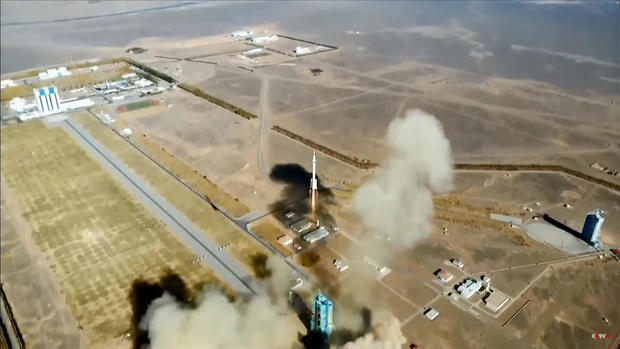
China has recently sent a new three-person team to the Tiangong space station.
China sent out a new team of three individuals to the Tiangong space station on Thursday morning to replace the current three “taikonauts” who have been living in orbit for six months.
At 11:14 a.m. local time, commander Tang Hongbo, Tang Shengjie, and Jiang Xinlin were launched into space from the Jiuquan Satellite Launch Center, located 850 miles west of Beijing. They were aboard the Shenzhou 17 ferry ship, which was mounted on a Long March 2F rocket.
Following a smooth ascent to orbit, the spacecraft was set free to maneuver independently, paving the way for a sequence of rocket propulsions to catch up with the Tiangong space station, also known as the “Heavenly Palace.” Docking was anticipated to occur approximately six and a half hours after liftoff.
On May 30, the team was sent to the laboratory. They spent some time giving their replacements a quick overview of how the station operates before preparing to come back to Earth at the beginning of next week.
Before leaving, the team intends to conduct a visual examination of Tiangong through photographs, which will offer the initial detailed pictures of the structure orbiting Earth.
The most recent mission – China’s sixth manned flight to the space station and its fourth since the start of continuous staffing in June 2022 – was broadcasted live on Chinese TV, showcasing impressive footage of the rocket’s journey to space and giving a glimpse into the taikonauts’ cockpit activities.
In 2021, Tang Hongbo embarked on his first journey into space as part of the Shenzhou 12 team, where he spent a total of 92 days on the station. For his second mission, his fellow crew members are also first-time space travelers.
During a press briefing before the flight, he stated that this is the second mission with astronauts for the China space station’s phase of application and development.
“On the previous occasion, I was involved in the building of the space station during the Shenzhou 12 mission. Now, our focus will be on conducting various scientific experiments and advancing in technology.”
They will also conduct a spacewalk to examine and potentially fix any damage caused by small debris hitting the station’s solar panels.
According to Lin Xigiang, deputy director of the China Manned Space Agency, the amount of space debris is on the rise. This means that it is likely that small objects in space will collide with larger, long-term operational spacecraft.
“The solar panel on the space station has sustained minor damage from multiple impacts by small objects in space. This was considered during the design process. Currently, the space station’s functions and performance metrics meet all requirements.”
According to Lin, the Shenzhou 17 crew will perform experimental maintenance through a spacewalk, as China intends to use its space station for at least a decade, and potentially even longer. Lin emphasized that this task is extremely difficult.
The Chinese space station consists of three large modules that are interconnected in a T-shaped design. The Tianhe core module, which was launched in April 2021, serves as the focal point of the station and includes crew quarters, life support systems, communication systems, spacecraft controls, an airlock, and several docking ports.
In 2022, two additional sizable components, Wentian and Mengtian, were connected to Tianhe.
The International Space Station, which weighs 450 tons, consists of over twelve pressurized modules from the United States, Russia, the European Space Agency, and Japan. Building started in 1998 and the laboratory has been continuously occupied by alternating teams of astronauts and cosmonauts since 2000.
The mass of the Tiangong station is approximately 100 tons and it is approximately one-third the size of the ISS. The station has had a permanent staff since June 2022 when the Shenzhou 14 crew arrived. Although smaller than the ISS, the Chinese laboratory is more modern and has advanced equipment, computers, and instruments.
Similarly to the International Space Station, Chinese authorities are also promoting the participation of foreign citizens in flights to their own space station.
Lin stated that they would like to invite the entire world to join in and cooperate with China’s space station flight missions, welcoming all countries and regions that prioritize the peaceful use of outer space.
The International Space Station (ISS) is expected to be brought back to Earth in 2030, making Tiangong the sole government-run space station in low-Earth orbit. NASA is relying on privately operated commercial space stations to offer research prospects in Earth’s orbit, as the agency focuses on returning to the moon within the next decade.
In 2030, China intends to send its own astronauts to the moon, furthering the competition in space between global superpowers.
Lin stated through an interpreter that we are actively promoting our development and construction efforts to ensure that we meet our goal of sending Chinese individuals to the moon by 2030 as planned.
“As the lunar landing mission advances and certain criteria are fulfilled, we will extend a formal invitation to global astronauts to join us in the mission and discover the wonders of the universe together.”
More More
Source: cbsnews.com


